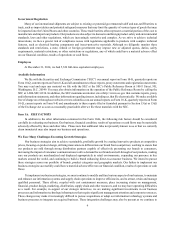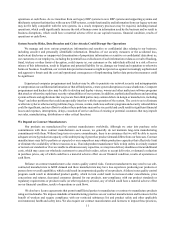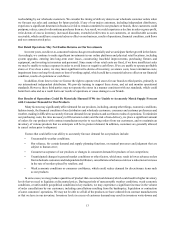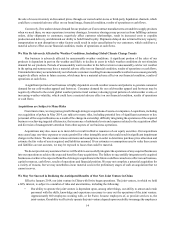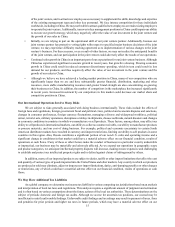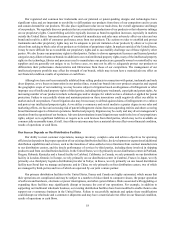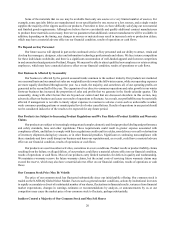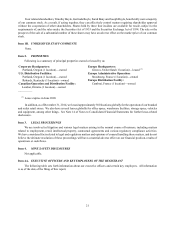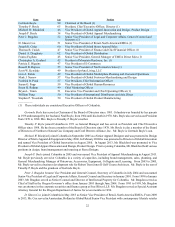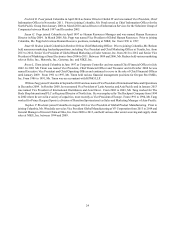Columbia Sportswear 2014 Annual Report Download - page 23
Download and view the complete annual report
Please find page 23 of the 2014 Columbia Sportswear annual report below. You can navigate through the pages in the report by either clicking on the pages listed below, or by using the keyword search tool below to find specific information within the annual report.19
The fixed costs associated with owning, operating and maintaining these large, highly automated distribution centers
during a period of economic weakness or declining sales can result in lower operating efficiencies, financial deleverage and
potential impairment in the recorded value of distribution assets. This has occurred in recent years in Europe, where our
distribution center is underutilized. This fixed cost structure globally may make it difficult for us to achieve or maintain
profitability if sales volumes decline for an extended period of time and could have material adverse effects on our financial
condition, results of operations or cash flows.
Our distribution facilities may also be interrupted by disasters, such as earthquakes, tornadoes or fires. We maintain
business interruption insurance, but it may not adequately protect us from the adverse effect that may be caused by significant
disruptions in our distribution facilities.
We May Be Adversely Affected by Currency Exchange Rate Fluctuations
Although the majority of our product purchases are denominated in U.S. dollars, the cost of these products may be
affected by relative changes in the value of the local currencies of our subsidiaries and our manufacturers. Price increases
caused by currency exchange rate fluctuations may make our products less competitive or have an adverse effect on our
margins. Our international revenues and expenses generally are derived from sales and operations in currencies other than
the U.S. dollar. Because the functional currency of many of our subsidiaries is not the U.S. dollar, we are exposed to the
potential of material gains or losses from the remeasurement of U.S. dollar monetary transactions into the respective
functional currencies. Currency exchange rate fluctuations may also disrupt the business of the contract manufacturers from
which we source our products by making their purchases of raw materials more expensive and more difficult to finance.
As a result, currency fluctuations may have a material adverse effect on our financial condition, results of operations or
cash flows.
All of our independent distributors purchase the vast majority of their inventory from us in U.S. dollars and, therefore,
are dependent upon their ability to exchange their functional currency for U.S. dollars on global currency exchanges. Some
of our distributors have experienced periods during which they have been unable to obtain U.S. dollars in sufficient quantity
to complete their purchase of goods or to pay amounts owed for past deliveries. In addition, sudden significant weakening
of a distributor's functional currency makes it more expensive for it to purchase our products and may result in significant
reductions in their future purchases and/or cancellations of prior advance orders. For example, recent economic turmoil has
significantly devalued the Russian ruble, resulting in reduced orders from our Russian distributor. Disruptions in currency
exchange markets may have a material adverse effect on our financial condition, results of operations, or cash flows.
Our Investments May Be Adversely Affected by Market Conditions
Our investment portfolio is subject to a number of risks and uncertainties. Changes in market conditions, such as
those that accompany an economic downturn or economic uncertainty, may negatively affect the value and liquidity of our
investment portfolio, perhaps significantly. Our ability to find diversified investments that are both safe and liquid and that
provide a reasonable return may be impaired, potentially resulting in lower interest income, less diversification, longer
investment maturities and/or other-than-temporary impairments.
We May Be Adversely Affected by Labor Disruptions
Our business depends on our ability to source and distribute products in a timely manner. While a majority of our
own operations are not subject to organized labor agreements, our relationship with our Cambrai distribution center
employees is governed by French law, including a formal representation of employees by a Works Council and the application
of a collective bargaining agreement. Labor disputes at contract manufacturers where our goods are produced, shipping
ports, transportation carriers, retail stores or distribution centers create significant risks for our business, particularly if these
disputes result in work slowdowns, lockouts, strikes or other disruptions during our peak manufacturing, shipping and
selling seasons. For example, recent work slowdowns and stoppages at ports on the west coast of the United States have
resulted in product delays and increased costs. Labor disruptions may have a material adverse effect on our business,
potentially resulting in cancelled orders by customers, unanticipated inventory accumulation, and reduced revenues and
earnings.
We Depend on Key Suppliers


